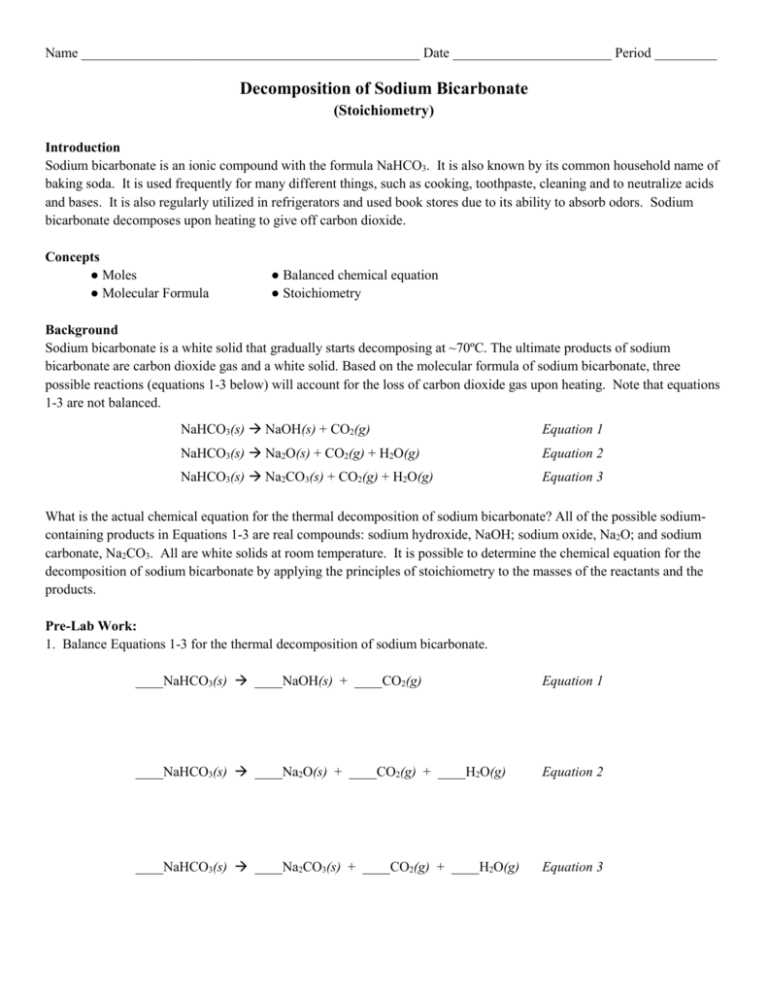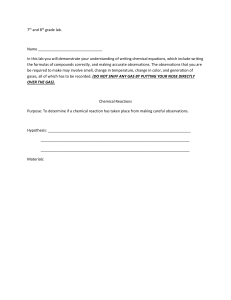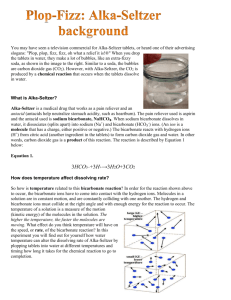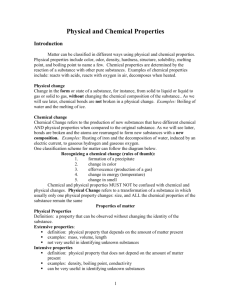Decomposition of Sodium Bicarbonate - Memorial HS Pre
advertisement

Name _________________________________________________ Date _______________________ Period _________ Decomposition of Sodium Bicarbonate (Stoichiometry) Introduction Sodium bicarbonate is an ionic compound with the formula NaHCO3. It is also known by its common household name of baking soda. It is used frequently for many different things, such as cooking, toothpaste, cleaning and to neutralize acids and bases. It is also regularly utilized in refrigerators and used book stores due to its ability to absorb odors. Sodium bicarbonate decomposes upon heating to give off carbon dioxide. Concepts ● Moles ● Molecular Formula ● Balanced chemical equation ● Stoichiometry Background Sodium bicarbonate is a white solid that gradually starts decomposing at ~70ºC. The ultimate products of sodium bicarbonate are carbon dioxide gas and a white solid. Based on the molecular formula of sodium bicarbonate, three possible reactions (equations 1-3 below) will account for the loss of carbon dioxide gas upon heating. Note that equations 1-3 are not balanced. NaHCO3(s) NaOH(s) + CO2(g) Equation 1 NaHCO3(s) Na2O(s) + CO2(g) + H2O(g) Equation 2 NaHCO3(s) Na2CO3(s) + CO2(g) + H2O(g) Equation 3 What is the actual chemical equation for the thermal decomposition of sodium bicarbonate? All of the possible sodiumcontaining products in Equations 1-3 are real compounds: sodium hydroxide, NaOH; sodium oxide, Na2O; and sodium carbonate, Na2CO3. All are white solids at room temperature. It is possible to determine the chemical equation for the decomposition of sodium bicarbonate by applying the principles of stoichiometry to the masses of the reactants and the products. Pre-Lab Work: 1. Balance Equations 1-3 for the thermal decomposition of sodium bicarbonate. ____NaHCO3(s) ____NaOH(s) + ____CO2(g) Equation 1 ____NaHCO3(s) ____Na2O(s) + ____CO2(g) + ____H2O(g) Equation 2 ____NaHCO3(s) ____Na2CO3(s) + ____CO2(g) + ____H2O(g) Equation 3 Materials Balance (0.01- or 0.001-g precision) Bunsen burner Sodium bicarbonate, 2.00 g Spatula Test tube Test tube clamp Wire Gauze Ring stand with iron ring Safety Precautions Safety goggles and aprons are required for this lab. Make sure to keep safety goggles on correctly at all times. Also remember not to point the open end of a test tube towards any person. Procedure 1. Obtain a small test tube. 2. Measure and record the mass of the test tube. 3. Using a spatula, add approximately 2.00 g of sodium bicarbonate to the bottom of the test tube. 4. Measure and record the combined mass of the test tube and sodium bicarbonate. 5. Place the wire gauze on the iron ring attached to the ring stand. 6. Carefully place the test tube horizontally on the wire gauze, being careful not to let the sodium bicarbonate come out. Make sure that the opening of the test tube is not pointed at anyone. 7. Light a Bunsen burner and place under the ring stand under the test tube. 8. Heat the test tube for 7 minutes. The solid in the test tube should begin to melt and bubble slightly. You should see droplets of H2O forming at the mouth of the tube. 9. Quickly remove the test tube from the flame if a white smoke is given off from the open end of the test tube. The smoke represents a loss of starting material due to evaporation of molten sodium bicarbonate and will reduce the yield of the product. A small amount of smoke may be inevitable and should not interfere with the accuracy of the results. 10.Using the test tube clamps move the test tube to the table to continue to cool for 5 minutes. 11.Heat the test tube again for 3 minutes until no more bubbling is observed and the material in the test tube has solidified. At this point, remove the Bunsen burner and turn it off. 12. Cool the test tube on the wire gauze for 5 minutes, then using test tube clamps move the test tube to the table to cool completely. 13. When the test tube has cooled to room temperature, measure the combined mass of the test tube and its solid contents. 14. Measure the mass a second time. If the second mass differs from the first mass by more than 0.02 g, repeat the heating cycle a third time. Data Table Mass (grams) Mass of empty test tube Mass of test tube + sodium bicarbonate INITIAL MASS of sodium bicarbonate Mass of test tube + solid product (1st heating) Mass of test tube + solid product (2nd heating) FINAL MASS of product Appearance of product 2 Post-Lab Calculations and Analysis (Use dimensional analysis and show all work, units and formulas to receive full credit. Answers must have units!) 1. Write the initial mass of sodium bicarbonate. ___________g NaHCO3 2. Use the initial mass of NaHCO3 to determine the expected (theoretical) amount, in grams, of each possible solid product. (Should have 3 separate stoichiometry problems) ___________g NaOH ____________g Na2O ___________g Na2CO3 3. What is the final (actual) mass of your product? ____________g product 4. Compare the actual mass of product obtained with the calculated or expected masses of each solid product. Write the formula and the name of the solid product formed in this reaction. 5. Write the balanced chemical equation for the decomposition of sodium bicarbonate observed in this lab. 6. Determine the percent yield for the solid product obtained in this reaction. #6 Answer: 3 7. Consider the following potential sources of error in this experiment. Using complete sentences, explain whether they would have caused the actual mass of solid product to be lower or higher than the expected (theoretical) value. a. The sodium bicarbonate did not decompose completely. b. The sodium bicarbonate was heated too fast, allowing considerable white smoke to escape from the test tube. c. The sodium bicarbonate absorbed some moisture from the air before the experiment began and was not completely dry. 4








